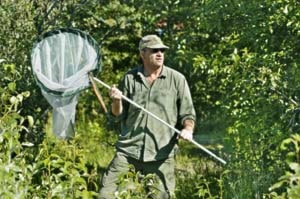In green, cotton fatigues Paul Catling looks like he should have a rifle slung over his shoulder.
Instead, he’s carrying a bug net.
“As a young guy, I used to run around with my insect net collecting bugs,” said Catling. “And I never gave up.”
Joined by 15 bug experts from across Canada, Catling was in Whitehorse last week for the Committee on the Status of Endangered Wildlife in Canada arthropods specialist subcommittee’s annual meeting, to assess insects and bugs at risk.
That’s why net-wielding arthropod experts were spotted batting bushes in and around town.
“We found quite a few interesting things,” said Catling.
“Including a new species of moth on Grey Mountain.”
The new moth is not much to look at, he added.
The small, creamy brown flyer is actually quite inconspicuous.
But insect aficionados consider it a thrilling find.
With more than 50,000 insect species in Canada alone, there are still hundreds of undiscovered bugs and insects, said Catling.
Most mammals and birds are well known, but insects aren’t as conspicuous, he said.
Popular insects, like butterflies, are easily recognized.
But small, innocuous insects, like beetles, are often overlooked.
Catling is particularly fond of dragonflies.
They’re pretty scarce in the Yukon, he said.
But there is one dragonfly here that doesn’t appear anywhere else in Canada — the treeline emerald dragonfly.
It’s one of many insect species in the territory associated with Siberia, said Catling.
Many species travelled across the Beringia land bridge, he said.
Which is why there is a lot of unusual flora and fauna in the Yukon.
This is the first time the arthropods subcommittee met in the territory, and many members took the opportunity to gather new and unusual specimens.
“The committee is interested in understanding what the situation is with insects in Canada,” said Catling.
“But, of course, learning what is causing insects to be at risk will also apply to flora and fauna more generally.”
There are no known insect species at risk in the Yukon, but the growing threat of climate change could change that, he said.
During their visit, the bug specialists visited Carmacks area.
This region remained unglaciated during the last ice age, and now is home to many species of flora and fauna not found anywhere else in Canada, said Catling.
“You get these high alpine areas in the mountains where insects that have been wiped out in the rest of Canada have been existing for thousands of years,” he said.
“But with climate change, the vegetation zones on the mountain may change.
“The woodlands could ascend up the sides of the mountain and, if the woodlands travel to the top of the mountain, the alpine zone will disappear entirely.”
This is one of the many threats that could jeopardize insect, plant and animal life that has a very restricted distribution, he said.
When insects are at risk, all life in that region is affected, said Catling.
The decline of several moths on the prairie sand dunes, for example, signals that many species in that waning habitat are in danger, he said.
“Insects, by virtue of their vast numbers, have a high impact on the environment, and their loss can upset the delicate balance of nature with serious consequences to people.”
There is an increasingly rapid loss of species due to human activity and its effects on the global environment, said Catling.
By recognizing human impact and making recommendations, the arthropods subcommittee hopes to protect more than just the insect species at risk.
“Protecting a few insects will likely contribute to the protection of many other species as well,” said Catling.
For instance, after two butterflies in southern Ontario’s grasslands disappeared, the habitat was protected, which helped to save numerous other species, he said.
Catling, who is a botanist as well as a bug lover, stayed in the territory an extra week, to study its grasslands.
“Although the animals, like the mammoths and giant sloth, that inhabited Beringia are gone, the grasslands that supported them have stayed relatively the same,” he said.
“So, I am taking advantage of my time here to study these plants.”
The arthropod experts, who met Monday through Wednesday of last week at the Riverview Hotel, were a diverse bunch.
Among them was a Mi’kmaq from Nova Scotia and a Manitoba Metis who shared their traditional knowledge; there was also a butterfly expert, an agri-food research scientist, a dragonfly expert and a spider specialist.
COSEWIC is recognized as the primary advisory body involved with the conservation of species at risk under a territorial, provincial and federal accord.
Critics charge Harper with failing endangered species
On June 5th, Ottawa missed an important deadline under Canada’s Species at Risk Act for preparing recovery plans for more than 105 endangered species, including the critically threatened Northern spotted owl, whooping crane, swift fox and Vancouver Island marmot.
Environmentalists are concerned the new Conservative Prime Minister Stephen Harper is washing his hands of Canada’s endangered species, according to a Sierra Club release.
“Wildlife cannot recover if its habitat is not identified and protected,” said Sierra Club biodiversity director Rachel Plotkin in the release.
“The initial track record does not bode well for critical habitat identification. If the federal government releases plans that are late and fail to identify critical habitat, they are going to have a lot to answer for.”
